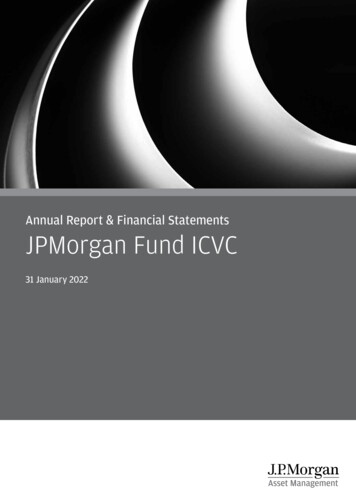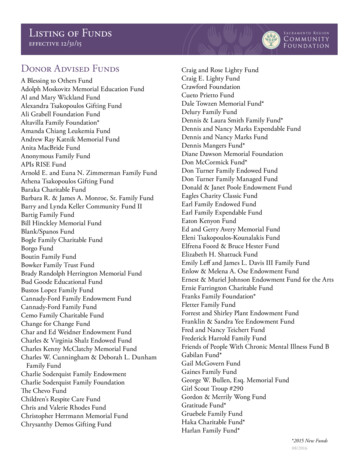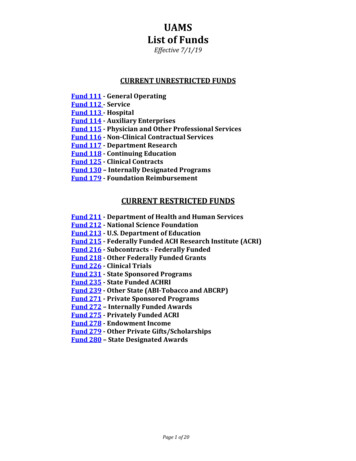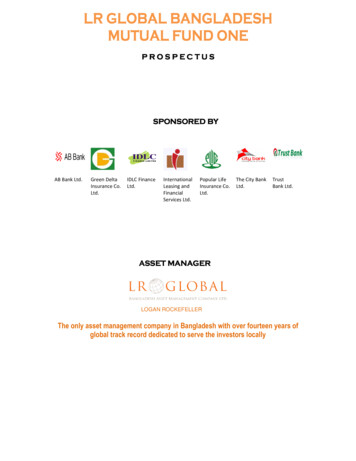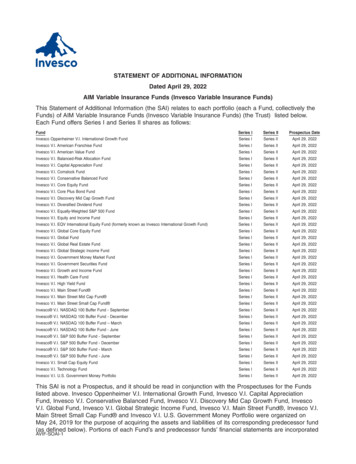
Transcription
Ask your Fund Manager„Wir können den Wind nicht ändern,aber die Segel anders setzen.“- AristotelesSeit dem Pariser Klimaabkommen haben nachhaltige Geldanlagen deutlich an Bedeutung gewonnen.In diesem Kontext laufen Eigentümer von Vermögenswerten Gefahr, massive Mengen ihrer Assets zuverlieren, wenn sie ihre festverzinslichen Portfoliosnicht rechtzeitig auf kohlenstoffarme Anlagen umstellen können. Ein integrierter Ansatz, der über reine Ausschlussverfahren hinausgeht, bietet Anlegerndie Chance, ihre CO2-Bilanz zu verringern, ohne dabei zusätzliche Risiken einzugehen oder auf Renditeverzichten zu müssen. Durch die Einbeziehung derCarbon Intensity (WACI Scope 1 2) in ihr proprietäres Default Probability Model zielt Blackstone Credit Systematic Strategies auf eine CO2-Ersparnis von50% gegenüber einer vergleichbaren Benchmark.Seite 1Blackstone Credit zielt mit neuer systematischerESG-Strategie auf Low Carbon abDie Reduzierung der Treibhausgasemissionen stehtim Vordergrund der politischen Agenda, da Länderauf der ganzen Welt bestrebt sind, bis 2050 NettoNull zu erreichen. An den Finanzmärkten konzentrieren sich Anleger zunehmend auf nachhaltigeAnlagen und tendieren zu Managern, die robusteStrategien anbieten können, die ihnen helfen, ihreESG-Ziele zu erreichen.Blackstone Credit Systematic Strategies „SystematicStrategies“ bereitet eine neue, nachhaltige FixedIncome-Lösung vor, die es Anlegern ermöglichensoll, ihre Portfolien zu dekarbonisieren, ohne diePerformance zu beeinträchtigen. Wie Sie als Anleger davon profitieren und warum dies einem ausschlussbasierten Verfahren gegenüber vorteilhaftsein kann, erfahren Sie im Interview mit Tim Kasta,Senior Managing Director und Co-Head of Blackstone Credit’s Systematic Strategies Einheit.
Tim KastaSenior Managing Director and Co-Headof Blackstone Credit’s Systematic StrategiesPrior to Blackstone’s acquisition of DCI in 2020, Mr.Kasta was CEO of DCI, LLC, which he joined at itsinception in 2004. Before joining DCI, Mr. Kasta wasPartner and Managing Director of KMV LLC wherehe held a variety of roles, including designing andleading the development and marketing of thefirm’s flagship web product – CreditEdge. After thesale of KMV to Moody’s in 2002, Mr. Kasta becameManaging Director of Moody’s Analytics (formerlyMoody’s KMV), where he was Co-Head of BusinessDevelopment and Head of Product Developmentfor the asset management sector. Mr. Kasta beganhis career in 1993 at Bank of Montreal in Torontowhere he was one of the original members of thecredit portfolio management team within corporatebanking.Mr. Kasta is a CFA charter holder and received his Bachelor of Arts (HBA) from the Ivey Business Schoolat Western University located in London, Ontario,Canada.About Blackstone Credit Systematic Strategies:Blackstone Credit Systematic Strategies (formerlyDCI) is an asset management firm specializing ininvestment grade and high yield corporate creditstrategies. The firm manages long-only and long/short strategies for some of the world‘s largestSeite 2institutional and private wealth investors. Blackstone Credit Systematic Strategies deploys a fundamental based, systematic approach seeking to exploitpotential inefficiencies in the corporate credit markets. The firm offers daily dealing funds includingregulated UCITS V compliant funds, offshore funds,onshore funds, and custom managed accounts. Thecofounders‘ achievements include the creation ofthe world‘s first equity index fund at Wells Fargoin 1971, cofounding Dimensional Fund Advisors in1981 and cofounding KMV in 1989. While at KMVbetween 1989 and 2002, a group of DCI‘s foundersand principals developed the world‘s first credit default probability model. This model was empirically shown to predict corporate defaults with moreprecision and accuracy than any previous methods.After Moody‘s acquired KMV, the team co-foundedDCI in 2004 with the singular objective of creatingwell-diversified portfolios that seek to produce consistent, low-volatility alpha. On December 18, 2020,The Blackstone Group Inc. acquired DCI, LLC whichhas become a part of Blackstone Credit the creditfocused business of Blackstone. DCI, LLC was subsequently renamed Blackstone Credit SystematicStrategies LLC.Learn more under:Blackstone Credit Systematic Strategies
Investment firms are looking to integrate sustainablefinance solutions across their fund strategies. How canBlackstone Credit Systematic Strategies help clients withthese goals?Systematic Strategies already incorporates responsibleinvesting across all our existing portfolios through Socially Responsible Investing exclusions. We have built onthis by converting a number of our Article 8 compliantUCITs1) strategies, including Global Investment Grade,U.S. High Yield and EUR Short Duration Bond to a lowcarbon offering.In a nutshell the low carbon strategy evaluates creditsbased on their carbon emissions, essentially targetingcompanies with the lowest carbon intensity scores tocreate a portfolio of assets with meaningfully less carbonexposure than the index.The Systematic Strategies selection process uses an optimizer that systematically identifies the highest alphacredits based on our fundamental credit models, whilecontrolling turnover and ensuring the portfolio remainsrisk-matched to the benchmark.That process starts with filtering out the least liquid issuers from the defined list of credits in the relevant indexto remove liquidity risk. In addition, the Socially Responsible Investing exclusions are applied to the index universe. Then the portfolio is matched against the creditbeta and interest rate risk of the index so that no macrobeta bets are taken. Finally, the model selects the namesdeemed to have the highest absolute mispricing relative to their market spreads and which are fundamentallyimproving. The spreads on these credits should tightenas the market rewards the firm’s improvement in creditquality to generate returns that are uncorrelated to theindex.Seite 3The low carbon approach extends upon this frameworkby adding a carbon constraint to the selection process toachieve a 50% lower weighted average carbon intensityscore (“WACI”) for the portfolio compared to the index.For reference, the WACI scores the portfolio’s exposureto carbon-intensive companies, based on a company’sScope 1 and Scope 2 carbon emissions relative to itsrevenue. Where carbon intensity is not available for acompany we use the subsector carbon intensity, which isthe ratio of the total emissions of the subsector over thetotal revenue in the subsector as of that date. If there isan insufficient number companies with data in the relevant subsector, we use the sector carbon intensity, whichis the ratio of the total emissions of the sector over thetotal revenue in the sector as of that date The measureallows for comparison across the portfolio regardless ofthe firm size.What’s the impact on the portfolio when converting tolow carbon?Our systematic investment process allows us to build ourcarbon targets directly into the portfolio construction.Carbon intensity becomes another condition in the portfolio optimization and is solved for dynamically so that asa firm’s WACI score changes, so will its relative weight inour portfolios. In reality there are currently only a smallnumber of credits in the indices with levels of carbonthat are meaningfully higher than the average, and webelieve those can be easily substituted. This makes itrelatively straightforward to create a portfolio with thesame excess return potential but with much lower carbon intensities and substantially reduced WACI relativeto the relevant index.The shift to low carbon format requires a minimal repositioning that could be executed over a normal month’strading at minimal cost.1)Blackstone Systematic Strategies UCITS Funds have been identified as Article 8 products under the EU’s Sustainable Finance Disclosure Regulation. Please visit https://www.blackstone.com/systematic-strategies/ for additional information.The reference to SFDR product categories is provided on the basis of the European Directive (EU) 2019/2088 on the sustainability-related disclosures in the financial servicessector (“SFD Regulation”) and state of knowledge as of 10 March 2021. As of publicationdate, the SFDR-related regulatory technical standards are not yet finalized and enforced.The product categorization shall be re-assessed once such regulatory technical standardsare completed and may evolve.
Investors want to move to ESG but without compromising on returns. How does the performance of the low carbonstrategy compare to the regular portfolio?Investors look to active managers to outperform an index and that is their chief concern. ESG solutions that reduce carbon exposure often call for excluding entire sectors which can come at a performance cost and/or additional trackingerror. Any solution that excludes entire sectors is going to result in a different return profile compared to the index, aswell as a smaller investible universe.By contrast our decarbonization strategy selects the least emissive names from an equivalent set of portfolio choicesthat the optimizer faces to preserve the overall expected portfolio performance while targeting low tracking error,something we think is compelling for investors.2) Note, while not part of the low carbon optimization process, the strategy will avoid certain issuers considered to be poor SRI performers from categories including but not limited to: (i) themining of coal; (ii) coal power generation; (iii) the manufacturing of tobacco products; (iv) the manufacture or sale ofweapons and/or ammunition; (v) the manufacture of opioids; (vi) and private prisons.Cumulative Return3)What about energy? Environmentally focused investors may have missed out on the outperformance of this sector thisyear following the rise in natural gas and oil prices. Are energy names excluded from the low carbon model?Energy has been one of the strongest performing sectors this year fueled by rising oil and natural gas prices. It’s alsoone of the largest sectors in the high yield market, with a 13.2% weighting in the benchmark (higher on a DTS/riskbasis). 4) For comparison energy is 8% of the investment grade market, and about 3% of the S&P 500 index. 5)Sector exclusions are not part of our general systematic approach, although we can easily accommodate any customsector exclusions or other SRI/ESG restrictions at the request of our clients, and it would be undesirable to exclude asector that represents such a large part of the index. Note, while not part of the low carbon optimization process, thestrategy will avoid certain issuers considered to be poor SRI performers from categories including but not limited to: (i)the mining of coal; (ii) coal power generation; (iii) the manufacturing of tobacco products; (iv) the manufacture or saleof weapons and/or ammunition; (v) the manufacture of opioids; (vi) and private prisons.Seite 4
Our research also shows that often it isn’t the energy names that are the worst carbon emitters, which means thatexcluding energy does not automatically lead to lower WACI compared to the index. If we converted our High Yieldstrategy to low carbon today the top three names that we would remove are all steel producers.6) Our low carbonapproach rewards energy companies that successfully transition to renewable energy sources as they stay in our investible universe rather than being permanently excluded from a manager’s investment strategy.Based on our backtest performance our Low Carbon Systematic High Yield Strategy outperforms both the ICE BofAMLU.S. High Yield Constrained Index and the ICE BofA US High Yield Excluding Energy, Metals & Mining Index (HXNM).We think the strategy is a win-win for investors who consider carbon intensity a good measure when it comes toworking towards ESG targets, allowing them opportunity to run a portfolio at 50% less carbon while still working tooutperform the index.Seite 5
Über Active Fund Placement:Active Fund Placement ist seit 2009 als Third Party Marketer für eineausgewählte Anzahl an best-in-class Fondsanbietern im deutschsprachigenRaum aktiv. Die Investmentstrategien werden sowohl bei InstitutionellenInvestoren als auch im Wholesale vertreten.Für weitere Informationen steht Ihnen unser Sales Team gerne zur Verfügung.Active Fund Placement GmbHSchäfergasse 52 60313 Frankfurt am MainTelefon: 49 69 34 872 77 99info@fundplacement.de www.fundplacement.deAmtsgericht Frankfurt am Main HRB 87594Geschäftsführer: Andreas Kümmert, Günther KümmertRechtliche Hinweise gem. §16 Abs. 2 und §17 FinVermVBitte beachten Sie, dass eine Beurteilung der Angemessenheit der Finanzanlagen im Sinne des § 16 Abs. 2 FinVermV mangelsder erforderlichen Informationen nicht möglich ist. Die Active Fund Placement GmbH erhält laufende Zuwendungen von Dritten(Produktgebern), die anteilig aus den jährlichen Verwaltungsvergütungen und Performance Fees der jeweiligen Fondsentnommen werden und bei der Active Fund Placement GmbH verbleiben. Die exakte Höhe der vereinnahmten Zuwendungenwird auf Wunsch jedem Investor offengelegt.Seite 6
Key Risk FactorsIn considering any investment performance information contained in the Materials, prospective and current investors should bear in mind that past or estimatedperformance is not necessarily indicative of future results and there can be no assurance that a Fund will achieve comparable results, implement its investmentstrategy, achieve its objectives or avoid substantial losses or that any expected returns will be met.Conflicts of Interest. There may be occasions when a Fund’s general partner and/or the investment advisor, and their affiliates will encounter potential conflictsof interest in connection with such Fund’s activities including, without limitation, the allocation of investment opportunities, relationships with Blackstone’s andits affiliates’ investment banking and advisory clients, and the diverse interests of such Fund’s limited partner group. There can be no assurance that the Sponsorwill identify, mitigate, or resolve all conflicts of interest in a manner that is favorable to the Partnership.Epidemics / Pandemics. Countries have been susceptible to epidemics which may be designated as pandemics by world health authorities, most recently COVID-19. The outbreak of such epidemics, together with any resulting restrictions on travel or quarantines imposed, has had and will continue to have a negativeimpact on the economy and business activity globally (including in the countries in which the Funds invest), and thereby is expected to adversely affect theperformance of the Funds’ investments. Furthermore, the rapid development of epidemics could preclude prediction as to their ultimate adverse impact oneconomic and market conditions, and, as a result, presents material uncertainty and risk with respect to the Funds and the performance of their investments.Forward-Looking Statements. Certain information contained in the Materials constitutes “forward-looking statements,” which can be identified by the use of forward-looking terminology or the negatives thereof. These may include financial predictions estimates and their underlying assumptions, statements about plans,objectives and expectations with respect to future operations, and statements regarding future performance. Such forward‐looking statements are inherentlyuncertain and there are or may be important factors that could cause actual outcomes or results to differ materially from those indicated in such statements.Blackstone believes these factors include but are not limited to those described under the section entitled “Risk Factors” in its Annual Report on Form 10‐Kfor the most recent fiscal year ended December 31 of that year, and any such updated factors included in its periodic filings with the Securities and ExchangeCommission, which are accessible on the SEC’s website at www.sec.gov. These factors should not be construed as exhaustive and should be read in conjunctionwith the other cautionary statements that are included in the Materials and in the filings. Blackstone undertakes no obligation to publicly update or review anyforward‐looking statement, whether as a result of new information, future developments or otherwise.Highly Competitive Market for Investment Opportunities. The activity of identifying, completing and realizing attractive investments is highly competitive, andinvolves a high degree of uncertainty. There can be no assurance that a Fund will be able to locate, consummate and exit investments that satisfy its objectivesor realize upon their values. There is no guarantee that investment opportunities will be allocated to a Fund and/or that the activities of Blackstone’s other fundswill not adversely affect the interests of such Fund.Leverage. A Fund may use leverage or borrow, subject to regulatory limitations where applicable. The use of leverage or borrowings magnifies investment, market and certain other risks and may be significant. A Fund’s performance will be affected by the availability and terms of any leverage as such leverage will enhance returns from investments to the extent such returns exceed the costs of borrowings by such Fund. The leveraged capital structure of such assets will increasetheir exposure to certain factors such as rising interest rates, downturns in the economy, or deterioration in the financial condition of such assets or industry. Inaddition, because a Fund will pay all expenses, including interest, associated with the use of leverage or borrowings, investors will indirectly bear such costs.Material, Non-Public Information. In connection with other activities of Blackstone, certain Blackstone personnel may acquire confidential or material non-publicinformation or be restricted from initiating transactions in certain securities, including on a Fund’s behalf. As such, a Fund may not be able to initiate a transactionor sell an investment. In addition, policies and procedures maintained by Blackstone to deter the inappropriate sharing of material non-public information maylimit the ability of Blackstone personnel to share information with personnel in Blackstone’s other business groups, which may ultimately reduce the positivesynergies expected to be realized by a Fund as part of the broader Blackstone investment platform.No Assurance of Investment Return. Prospective investors should be aware that an investment in a Fund is speculative and involves a high degree of risk. Therecan be no assurance that a Fund will achieve comparable results, implement its investment strategy, achieve its objectives or avoid substantial losses or that anyexpected returns will be met (or that the returns will be commensurate with the risks of investing in the type of transactions described herein). The portfoliocompanies in which a Fund may invest (directly or indirectly) are speculative investments and will be subject to significant business and financial risks. A Fund’sperformance may be volatile. An investment should only be considered by sophisticated investors who can afford to lose all or a substantial amount of theirinvestment. A Fund’s fees and expenses may offset or exceed its profits.Reliance on Key Management Personnel. The success of a Fund will depend, in large part, upon the skill and expertise of certain Blackstone professionals. In theevent of the death, disability or departure of any key Blackstone professionals, the business and the performance of a Fund may be adversely affected. . SomeBlackstone professionals may have other responsibilities, including senior management responsibilities, throughout Blackstone and, therefore, conflicts areexpected to arise in the allocation of such personnel’s time (including as a result of such personnel deriving financial benefit from these other activities, includingfees and performance-based compensation).Sustainable Finance Disclosure Regulation („SFDR“). The Systematic UCITS funds, in consultation with Blackstone, have identified certain Systematic UCITS fundsas Article 8 for the purposes of SFDR. Systematic UCITS funds may seek to make sustainable investments including investments in economic activities that qualifyas environmentally sustainable under Article 3 of Regulation (EU) 2020/852 (the „Taxonomy“). At this time the Systematic UCITS funds have not identified aproportion of investments in such activities or proportion of investments which relate to enabling or transitional activities as referred to in Article 16 and Article10(2) of the Taxonomy but that may be subject to change. The Taxonomy sets out a “do not significant harm” principle by which Taxonomy-aligned investmentsshould not significantly harm Taxonomy objectives and is accompanied by specific EU criteria. Similarly, any other sustainable investments must also not significantly harm any environmental or social objectives. The “do no significant harm” principle applies only to sustainable investments (if any). Other investments donot take into account the EU criteria for environmentally sustainable economic activities and are not required to apply the “do no significant harm” principle. Itis possible that none of the investments underlying the Systematic UCITS funds will take into account the EU criteria for environmentally sustainable economicactivities.Seite 7
Important Disclosure InformationWhile Blackstone believes responsible investing can enhance value, Blackstone does not pursue an exclusively ESG-based investment strategy or limit its investments to those that meet specific ESG criteria or standards. Any reference to Blackstone‘s firm-wide environmental or social considerations is not intended toqualify Blackstone‘s duty to maximize risk-adjusted returns nor does Blackstone guarantee any ESG initiatives will occur as expected or at all.Data from inception (January 2010) as of September 30, 2021. Past performance is not necessarily indicative of future results. There can be no assurance that theFund will achieve its objectives or avoid significant losses. Performance is based on backtesting returns. Returns are hypothetical results achieved by the retroactive application of a model that has been prepared for general information purposes for consideration by sophisticated prospective investors in the Strategy.The returns are not the actual historical results of the Strategy and accordingly are subject to inherent limitations. The information in this presentation maycontain projections or other forward-looking statements regarding future events or expectations. There is no guarantee that the backtest returns, allocations andprojections will be realized or achieved and investors may experience a loss. Investors should keep in mind that markets are volatile and unpredictable. Pleasesee Important Disclosure Information and the Limitations of Backtesting Performance Returns. Gross returns are before fees and expenses and net of simulatedtransaction costs. Net returns are shown after fees and expenses. For illustrative purposes. Backtesting returns are not indicative of past or future results, andthere can be no assurance that a fund has or will achieve comparable results. Actual results may vary materially. The volatility and risk profile of the indices presented is likely to be materially different from that of a Fund. In addition, the indices employ different investment guidelines and criteria than a Fund and do notemploy leverage; as a result, the holdings in a Fund and the liquidity of such holdings may differ significantly from the securities that comprise the indices.This document (together with any attachments, appendices, and related materials, the “Materials”) is provided on a confidential basis for informational duediligence and/or client reporting purposes only and is not, and may not be relied on in any manner as legal, tax, investment, accounting or other advice or as anoffer to sell, or a solicitation of an offer to buy, any security or instrument in or to participate in any trading strategy with Blackstone Credit, Blackstone Credit Systematic Strategies („BXCSS“) (formerly DCI, LLC) or its affiliates in the credit-focused business of Blackstone Inc. (together with its affiliates, “Blackstone” and, collectively, “BX Credit”) or any fund or separately managed account currently or to be sponsored, managed, advised or sub-advised or pursued by BX Credit (each,a “Fund” or “Strategy”), nor shall it or the fact of its distribution form the basis of, or be relied on in connection with, any contract or investment decision. If suchoffer is made, it will only be made by means of a prospectus and any supplements thereto (collectively with additional offering documents, the “Offering Documents”), which would contain material information (including certain risks of investing in such Fund) not contained in the Materials and which would supersedeand qualify in its entirety the information set forth in the Materials. The Offering Documents (including the prospectuses, supplements and where applicable KeyInvestor Information document) are available by request of the Fund Administrator or at dciinfo@blackstone.com. Any decision to invest in a Fund should bemade after reviewing the Offering Documents of such Fund, conducting such investigations as the investor deems necessary and consulting the investor’s own legal, accounting and tax advisers to make an independent determination of the suitability and consequences of an investment in such Fund. In the event that thedescriptions or terms described herein are inconsistent with or contrary to the descriptions in or terms of the Offering Documents, the Offering Documents shallcontrol. None of Blackstone, its funds, nor any of their affiliates makes any representation or warranty, express or implied, as to the accuracy or completeness ofthe information contained herein and nothing contained herein should be relied upon as a promise or representation as to past or future performance of a Fundor any other entity, transaction, or investment. Capitalized terms used herein but not otherwise defined have the meanings set forth in the Offering Documents.The information contained herein is unaudited and preliminary. Final amounts will not be available until a later date. The difference between the preliminary andthe final amounts could be material.In considering any investment performance information contained in the Materials, prospective and current investors should bear in mind that past or estimatedperformance is not necessarily indicative of future results and there can be no assurance that a Fund will achieve comparable results, implement its investment strategy, achieve its objectives or avoid substantial losses or that any expected returns will be met. The Fund may not achieve the desired results due toimplementation lag, other timing factors, portfolio management decision making, economic or market conditions or other unanticipated factors. The Fund‘sperformance information has been derived from its monthly net asset value. Monthly performance results have not been audited; however, the Fund‘s financialstatements for past fiscal years have been audited. Certain factors may cause monthly performance to vary from investor to investor. The performance resultsof an actual client investment advisory account invested by BXCSS in accordance with the Strategy would be reduced by the advisory fees and performance feesactually incurred in the management of the account; these and other expenses are not reflected in the actual Gross Returns. For example, an investment accountthat over a five-year period had an average annual investment return of 8% before deduction of an 0.35% annual investment advisory fee would have had alower average annual investment return of 7.65% after deduction of such annual investment advisory fee. For individual investor performance, investors shouldrely on information contained in account statements produced by the Fund‘s administrator. Fund performance shown for the performance period reflects aFund‘s return since inception and is based on the actual management fees and expenses paid by Fund investors as a whole.Seite 8
Performance for individual investors will vary (in some cases materially) from the performance stated herein as a result of the management fees paid or not paidby certain investors; the investor servicing fees paid by certain investors, as applicable; the timing of their investment; and/or their individual participation inFund investments. Fund performance shown may not reflect returns experienced by any particular investor in a Fund since actual returns to investors dependon when each investor invested in such Fund, which may be at a point in time subsequent to a Fund‘s equalization period, if applicable. The Fund‘s Documentscontain detailed provisions relating to the timing, methodology and recording of fund expenses, including incentive and management fees. An investment in theFund is subject to significant risks and is suitable only for investors of substantial financial means that have no need for immediate liquidity in this investment.The Fund uses sophisticated investment techniques and may not be suitable for all investors. The BXCSS fee schedule is presented in its Form ADV Part 2A.The Materials contain highly confidential information regarding Blackstone and a Fund’s investments, strategy and organization. Your acceptance of the Materialsconstitutes your agreement that the Materials are designated as “trade secret” and “highly confidential” by Blackstone and are neither publicly available nor dothey constitute a public record and that you shall (i) keep confidential all the information contained in the Materials, as well as any information derived by youfrom the information contained in the Materials (collectively, “Confidential Information”) and not disclose any such Confidential I
firm's flagship web product - CreditEdge. After the sale of KMV to Moody's in 2002, Mr. Kasta became Managing Director of Moody's Analytics (formerly Moody's KMV), where he was Co-Head of Business Development and Head of Product Development for the asset management sector. Mr. Kasta began his career in 1993 at Bank of Montreal in Toronto


